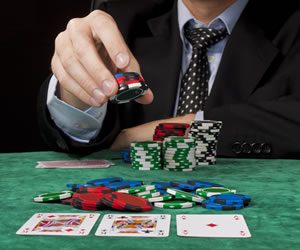 Balance (balancing) is not limited to just balancing different hands. It can also be applied to balancing bet sizes.
Balance (balancing) is not limited to just balancing different hands. It can also be applied to balancing bet sizes.
If you think this is something completely separate from hand range balance, it might seem that this topic will be particularly difficult. But it is simpler than it might appear.
Balancing bets simply means that each individual bet size must be balanced independently, that is, each bet size should be treated as its own range. If you have only one bet size in a certain situation, then the task is very easy, but there are many spots where you will have more than one “go to” or predetermined bet size. None of us will ever use all possible sizes in every situation, so players usually have two or three predetermined bet sizes and rarely more. If you imagine one bet size simply as a separate range from another bet size, we would have a series of arguments about range balance, leading to the theory of bet size balancing.
Let's take an example. Imagine you 3-bet against your opponent preflop and he calls, the board comes K♠Q♠5♦3♦7♥ and you bet on each street. You might have three different bet sizes on the river: 3/4 pot, which is a standard size and includes top pair, 1 and 1/4 pot overbet, which signifies nuts for value, such as two pairs or sets, and a smaller 1/2 pot bet, which would signify weak kings and AQ for value. Other hands, besides those listed, would be used for bluffing, and each would be applied in different proportions depending on the situation, so how to distribute the bluffs?
We could decide to achieve perfect balance in each range by applying some simple math, determining pot sizes, and directing the mix of bluffs and value so that it becomes an unbeatable strategy. But do we really want that?
First, let's remember the fundamental theorem of balance, which says: we should use a hand to balance a bet size if and only if the EV of that hand, calculated by averaging the bet sizes over the session, is greater than the EV we would get if the hand were simply played in a vacuum.
Keep in mind, for bet size balance to be beneficial, you must figure out where your opponent's attention is directed. If he is simply ignoring, inattentive, relying on assumptions, or completely gathering no information each time he folds, then the need for balance is low, as it will simply not affect the game with such an opponent in the future. An obvious example is when a super fish sits in a game among competent players. There are good opponents who will never call a 1/3 pot size bet in certain river situations because they conclude you are playing for small value. And there are opponents who will never call overbets on run-outs because they think no one bluffs in such spots. Since your opponent gets no information about your game and is likely to stick firmly to his assumptions about how people play in certain situations, without paying attention to your individual style, you can exploit them maximally in such situations. But in spots that are close to the center or very clearly visible situations, bet size balance becomes much more important.
We have reached a more complex level, choosing a bet size. The balance between one bet size and another, comparatively, is a fairly easy decision. But how to decide how much to actually bet? This is another question of holistic poker theory.
Let's take an example. We are 100bb deep, we 3-bet against an opponent preflop, he calls, the flop comes A♠2♦3♥, with 20bb in the pot. For simplicity, let's say we choose one bet size for our entire range. We can choose 5bb, 10bb, or 15bb. How will we make the decision?
First, let's ask ourselves: What does this size allow us to do with our entire range? Remember, at any moment on this board, we can have KK, AQo, or 79dd, and in such a case, we want to make the best decision. But to manage balance well, we must think holistically.
Instead of thinking about the best bet size for our hand, we must think: what is the best bet size for my average hand? In other words, what effect does my bet have on all the hands I will have during this game, not just the hand I have now.
In this specific spot, the answer would be close to 5bb, as it is a WA/WB (way-ahead/way-behind) type of board, if the board had more possible draws, where your opponent has more opportunities to have significant equity, the bet would be larger. But as always, it depends on many things. The most important of them is how often the opponent folds seeing different bet sizes, this spot always needs to be investigated. If you can find a bet size that your opponent is convinced no one bluffs with, then you have found the golden goose.





